Adult NG2+ cells are permissive to neurite outgrowth and stabilize sensory axons during macrophage-induced axonal dieback after spinal cord injury
- PMID: 20053907
- PMCID: PMC2823089
- DOI: 10.1523/JNEUROSCI.3705-09.2010
Adult NG2+ cells are permissive to neurite outgrowth and stabilize sensory axons during macrophage-induced axonal dieback after spinal cord injury
Abstract
We previously demonstrated that activated ED1+ macrophages induce extensive axonal dieback of dystrophic sensory axons in vivo and in vitro. Interestingly, after spinal cord injury, the regenerating front of axons is typically found in areas rich in ED1+ cells, but devoid of reactive astrocyte processes. These observations suggested that another cell type must be present in these areas to counteract deleterious effects of macrophages. Cells expressing the purportedly inhibitory chondroitin sulfate proteoglycan NG2 proliferate in the lesion and intermingle with macrophages, but their influence on regeneration is highly controversial. Our in vivo analysis of dorsal column crush lesions confirms the close association between NG2+ cells and injured axons. We hypothesized that NG2+ cells were growth promoting and thereby served to increase axonal stability following spinal cord injury. We observed that the interactions between dystrophic adult sensory neurons and primary NG2+ cells derived from the adult spinal cord can indeed stabilize the dystrophic growth cone during macrophage attack. NG2+ cells expressed high levels of laminin and fibronectin, which promote neurite outgrowth on the surface of these cells. Our data also demonstrate that NG2+ cells, but not astrocytes, use matrix metalloproteases to extend across a region of inhibitory proteoglycan, and provide a permissive bridge for adult sensory axons. These data support the hypothesis that NG2+ cells are not inhibitory to regenerating sensory axons and, in fact, they may provide a favorable substrate that can stabilize the regenerating front of dystrophic axons in the inhibitory environment of the glial scar.
Figures


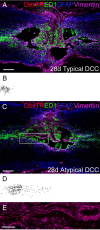

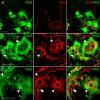
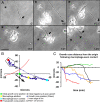

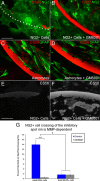
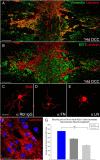

Similar articles
-
Axonal regeneration through regions of chondroitin sulfate proteoglycan deposition after spinal cord injury: a balance of permissiveness and inhibition.J Neurosci. 2003 Oct 15;23(28):9276-88. doi: 10.1523/JNEUROSCI.23-28-09276.2003. J Neurosci. 2003. PMID: 14561854 Free PMC article.
-
Entrapment via synaptic-like connections between NG2 proteoglycan+ cells and dystrophic axons in the lesion plays a role in regeneration failure after spinal cord injury.J Neurosci. 2014 Dec 3;34(49):16369-84. doi: 10.1523/JNEUROSCI.1309-14.2014. J Neurosci. 2014. PMID: 25471575 Free PMC article.
-
Multipotent adult progenitor cells prevent macrophage-mediated axonal dieback and promote regrowth after spinal cord injury.J Neurosci. 2011 Jan 19;31(3):944-53. doi: 10.1523/JNEUROSCI.3566-10.2011. J Neurosci. 2011. PMID: 21248119 Free PMC article.
-
Neurite outgrowth inhibitors in gliotic tissue.Adv Exp Med Biol. 1999;468:207-24. doi: 10.1007/978-1-4615-4685-6_17. Adv Exp Med Biol. 1999. PMID: 10635031 Review.
-
Sensory axon regeneration: rebuilding functional connections in the spinal cord.Trends Neurosci. 2012 Mar;35(3):156-63. doi: 10.1016/j.tins.2011.10.006. Epub 2011 Nov 30. Trends Neurosci. 2012. PMID: 22137336 Free PMC article. Review.
Cited by
-
A novel compound, denosomin, ameliorates spinal cord injury via axonal growth associated with astrocyte-secreted vimentin.Br J Pharmacol. 2013 Feb;168(4):903-19. doi: 10.1111/j.1476-5381.2012.02211.x. Br J Pharmacol. 2013. PMID: 22978525 Free PMC article.
-
Planet of the AAVs: The Spinal Cord Injury Episode.Biomedicines. 2021 May 28;9(6):613. doi: 10.3390/biomedicines9060613. Biomedicines. 2021. PMID: 34071245 Free PMC article. Review.
-
Axonal regeneration in zebrafish spinal cord.Regeneration (Oxf). 2018 Apr 22;5(1):43-60. doi: 10.1002/reg2.99. eCollection 2018 Mar. Regeneration (Oxf). 2018. PMID: 29721326 Free PMC article. Review.
-
Mesenchymal Stem Cell Protection of Neurons against Glutamate Excitotoxicity Involves Reduction of NMDA-Triggered Calcium Responses and Surface GluR1, and Is Partly Mediated by TNF.Int J Mol Sci. 2018 Feb 25;19(3):651. doi: 10.3390/ijms19030651. Int J Mol Sci. 2018. PMID: 29495345 Free PMC article.
-
The fibrotic scar in neurological disorders.Brain Pathol. 2014 Jul;24(4):404-13. doi: 10.1111/bpa.12162. Brain Pathol. 2014. PMID: 24946078 Free PMC article.
References
-
- Ben-Hur T, Ben-Yosef Y, Mizrachi-Kol R, Ben-Menachem O, Miller A. Cytokine-mediated modulation of MMPs and TIMPs in multipotential neural precursor cells. J Neuroimmunol. 2006;175:12–18. - PubMed
-
- Bergles DE, Roberts JD, Somogyi P, Jahr CE. Glutamatergic synapses on oligodendrocyte precursor cells in the hippocampus. Nature. 2000;405:187–191. - PubMed
-
- Bodega G, Suárez I, Rubio M, Fernández B. Ependyma: phylogenetic evolution of glial fibrillary acidic protein (GFAP) and vimentin expression in vertebrate spinal cord. Histochemistry. 1994;102:113–122. - PubMed
-
- Bradbury EJ, Moon LD, Popat RJ, King VR, Bennett GS, Patel PN, Fawcett JW, McMahon SB. Chondroitinase ABC promotes functional recovery after spinal cord injury. Nature. 2002;416:636–640. - PubMed
Publication types
MeSH terms
Substances
Grants and funding
LinkOut - more resources
Full Text Sources
Medical
Molecular Biology Databases
